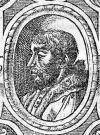Biography
Maurice Scève (c. 1500-c. 1564), French poet, was born at Lyon, where his father practised law.
He was the centre of the Lyonnese côterie that elaborated the theory of spiritual love, derived partly from Plato and partly from Petrarch. This spiritual love, which animated Antoine Héroet's Parfaicte Amye (1543) as well, owed much to Marsilio Ficino (1433-1499), the Florentine translator and commentator of Plato's works.
Scève's chief works are Délie, objet de plus haulte vertu (1544); three anatomical blazons (La Gorge, Le Sourcil, La Larme); the elegy Arion (1536) and the eclogue La Saulsaye (1547); and Microcosme (1562), an encyclopaedic poem beginning with the fall of man. Délie consists of 449 dizains (10-line epigrammes) preceded by a dedicatory "huitain" to his mistress, ("A sa Délie"). The poems alternate with 50 emblems, which include an image and a motto, the latter generally taken up from the last line of the following "dizain". The collection thus reflects the more general sixteenth-century vogue for emblem books (A. Alciati's emblems are particularly characteristic of the genre). Scève's epigrams, which have seen renewed critical interest since the late nineteenth century, were seen as difficult even in Scève's own day, although Scève was praised by Du Bellay, Ronsard, Pontus de Tyard and Des Autels for raising French poetry to new, higher aesthetic standards. His enthusiastic admirer Étienne Dolet confesses he could not understand them.
Scève was also a well versed musician as well as a poet; he cared very much for the musical value of the words he used, in this and in his erudition he forms a link between the school of Marot and the Pléiade. Délie (sometimes understood as an anagram for l'idée) is the first French "canzoniere" or poetic collection modeled after Petrarch's Canzoiere, a series of love poems addressed to a Lady. Scève was soon followed by Ronsard in Les Amours de Cassandre and by Du Bellay in Olive, these times collections of sonnets.
The Lyonnese school, of which Scève was the leader, included his friend Claude de Taillemont and the women writers Jeanne Gaillarde--placed by Marot on an equality with Christine de Pisan, Pernette du Guillet, Louise Labé, Clémence de Bourges and the poet's sisters, Claudine and Sibyile Scéve. Scève died sometime after 1560; the exact date is unknown. ..






